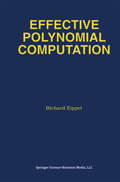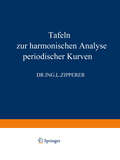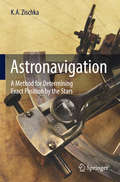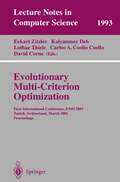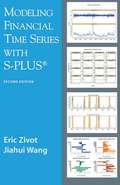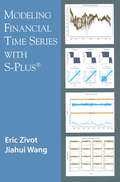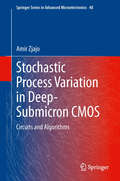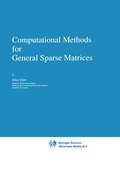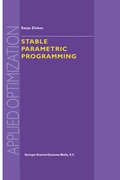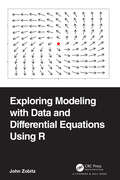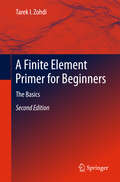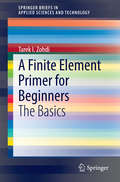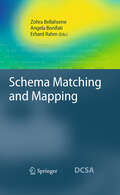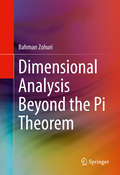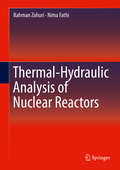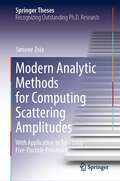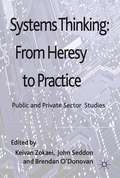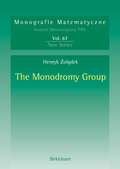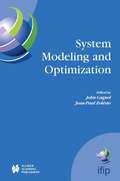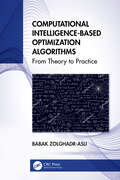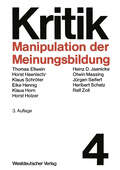- Table View
- List View
Effective Polynomial Computation (The Springer International Series in Engineering and Computer Science #241)
by Richard ZippelEffective Polynomial Computation is an introduction to the algorithms of computer algebra. It discusses the basic algorithms for manipulating polynomials including factoring polynomials. These algorithms are discussed from both a theoretical and practical perspective. Those cases where theoretically optimal algorithms are inappropriate are discussed and the practical alternatives are explained. Effective Polynomial Computation provides much of the mathematical motivation of the algorithms discussed to help the reader appreciate the mathematical mechanisms underlying the algorithms, and so that the algorithms will not appear to be constructed out of whole cloth. Preparatory to the discussion of algorithms for polynomials, the first third of this book discusses related issues in elementary number theory. These results are either used in later algorithms (e.g. the discussion of lattices and Diophantine approximation), or analogs of the number theoretic algorithms are used for polynomial problems (e.g. Euclidean algorithm and p-adic numbers). Among the unique features of Effective Polynomial Computation is the detailed material on greatest common divisor and factoring algorithms for sparse multivariate polynomials. In addition, both deterministic and probabilistic algorithms for irreducibility testing of polynomials are discussed.
Tafeln zur Harmonischen Analyse Periodischer Kurven
by L. ZippererDieser Buchtitel ist Teil des Digitalisierungsprojekts Springer Book Archives mit Publikationen, die seit den Anfängen des Verlags von 1842 erschienen sind. Der Verlag stellt mit diesem Archiv Quellen für die historische wie auch die disziplingeschichtliche Forschung zur Verfügung, die jeweils im historischen Kontext betrachtet werden müssen. Dieser Titel erschien in der Zeit vor 1945 und wird daher in seiner zeittypischen politisch-ideologischen Ausrichtung vom Verlag nicht beworben.
Astronavigation: A Method for Determining Exact Position by the Stars
by K. A. ZischkaThis book acts as a manual for the ancient methods of navigating by the stars, which continue to provide the sailor or pilot with a timeless means of determining location. Despite the prevalence of GPS, a comprehensive set of formulae that can be evaluated on any inexpensive scientific calculator in the event of a catastrophic software or systems failure is a vital failsafe. It also serves as a living link to centuries of explorers from centuries past. Beginning with the basics of positional astronomy, this guide moves on to the more complex math necessary to understand the ephemerides, tables showing the future positions of the stars and planets. These astronomical almanacs were the satellite navigation of their day. The objective of this book is twofold: to provide the reader with a concise, comprehensible manual on positional astronomy as it applies to astro-navigation and to furnish the concise algorithms for finding the position of the Sun and various navigational stars at any given instant.In a world where too many mariners and aeronauts rely solely on technology and are vulnerable to solar flares, electrical issues, and the like, this knowledge can be a life-saving backup, not to mention a fascinating study in its own rights. Included is an exact mathematical way to determine your position in the air or on the sea far more quickly and accurately than by using the old celestial navigational method, without even needing to know or understand the underlying mathematics. There is even a section that teaches how to measure the azimuth of a star using an analog wrist watch so if a sextant gets damaged, locating position is still possible. This book offers mathematicians and adventurers a way to determine position when the skies go dark.The U.S. Navy has recently realized that their electronic navigation systems are vulnerable to cyberattack, and as a result has instructed the Naval Academy to begin teaching celestial navigation again.
Evolutionary Multi-Criterion Optimization: First International Conference, EMO 2001, Zurich, Switzerland, March 7-9, 2001 Proceedings (Lecture Notes in Computer Science #1993)
by Eckart Zitzler Kalyanmoy Deb Lothar Thiele Carlos Coello Coello David CorneThis book constitutes the refereed proceedings of the First International Conference on Multi-Criterion Optimization, EMO 2001, held in Zurich, Switzerland in March 2001.The 45 revised full papers presented were carefully reviewed and selected from a total of 87 submissions. Also included are two tutorial surveys and two invited papers. The book is organized in topical sections on algorithm improvements, performance assessment and comparison, constraint handling and problem decomposition, uncertainty and noise, hybrid and alternative methods, scheduling, and applications of multi-objective optimization in a variety of fields.
Modeling Financial Time Series with S-PLUS®
by Eric Zivot Jiahui WangThis book represents an integration of theory, methods, and examples using the S-PLUS statistical modeling language and the S+FinMetrics module to facilitate the practice of financial econometrics. It is the first book to show the power of S-PLUS for the analysis of time series data. It is written for researchers and practitioners in the finance industry, academic researchers in economics and finance, and advanced MBA and graduate students in economics and finance. Readers are assumed to have a basic knowledge of S-PLUS and a solid grounding in basic statistics and time series concepts. This edition covers S+FinMetrics 2.0 and includes new chapters.
Linear Algebra in Data Science (Compact Textbooks in Mathematics)
by Peter Zizler Roberta La HayeThis textbook explores applications of linear algebra in data science at an introductory level, showing readers how the two are deeply connected. The authors accomplish this by offering exercises that escalate in complexity, many of which incorporate MATLAB. Practice projects appear as well for students to better understand the real-world applications of the material covered in a standard linear algebra course. Some topics covered include singular value decomposition, convolution, frequency filtering, and neural networks. Linear Algebra in Data Science is suitable as a supplement to a standard linear algebra course.
Stochastic Process Variation in Deep-Submicron CMOS: Circuits and Algorithms (Springer Series in Advanced Microelectronics #48)
by Amir ZjajoOne of the most notable features of nanometer scale CMOS technology is the increasing magnitude of variability of the key device parameters affecting performance of integrated circuits. The growth of variability can be attributed to multiple factors, including the difficulty of manufacturing control, the emergence of new systematic variation-generating mechanisms, and most importantly, the increase in atomic-scale randomness, where device operation must be described as a stochastic process. In addition to wide-sense stationary stochastic device variability and temperature variation, existence of non-stationary stochastic electrical noise associated with fundamental processes in integrated-circuit devices represents an elementary limit on the performance of electronic circuits.In an attempt to address these issues, Stochastic Process Variation in Deep-Submicron CMOS: Circuits and Algorithms offers unique combination of mathematical treatment of random process variation, electrical noise and temperature and necessary circuit realizations for on-chip monitoring and performance calibration. The associated problems are addressed at various abstraction levels, i.e. circuit level, architecture level and system level. It therefore provides a broad view on the various solutions that have to be used and their possible combination in very effective complementary techniques for both analog/mixed-signal and digital circuits. The feasibility of the described algorithms and built-in circuitry has been verified by measurements from the silicon prototypes fabricated in standard 90 nm and 65 nm CMOS technology.
Computational Methods for General Sparse Matrices (Mathematics and Its Applications #65)
by Zahari ZlatevStable Parametric Programming (Applied Optimization #57)
by S. ZlobecOptimality and stability are two important notions in applied mathematics. This book is a study of these notions and their relationship in linear and convex parametric programming models. It begins with a survey of basic optimality conditions in nonlinear programming. Then new results in convex programming, using LFS functions, for single-objective, multi-objective, differentiable and non-smooth programs are introduced. Parametric programming models are studied using basic tools of point-to-set topology. Stability of the models is introduced, essentially, as continuity of the feasible set of decision variables under continuous perturbations of the parameters. Perturbations that preserve this continuity are regions of stability. It is shown how these regions can be identified. The main results on stability are characterizations of locally and globally optimal parameters for stable and also for unstable perturbations. The results are straightened for linear models and bi-level programs. Some of the results are extended to abstract spaces after considering parameters as `controls'. Illustrations from diverse fields, such as data envelopment analysis, management, von Stackelberg games of market economy, and navigation problems are given and several case studies are solved by finding optimal parameters. The book has been written in an analytic spirit. Many results appear here for the first time in book form. Audience: The book is written at the level of a first-year graduate course in optimization for students with varied backgrounds interested in modeling of real-life problems. It is expected that the reader has been exposed to a prior elementary course in optimization, such as linear or non-linear programming. The last section of the book requires some knowledge of functional analysis.
Exploring Modeling with Data and Differential Equations Using R
by John ZobitzExploring Modeling with Data and Differential Equations Using R provides a unique introduction to differential equations with applications to the biological and other natural sciences. Additionally, model parameterization and simulation of stochastic differential equations are explored, providing additional tools for model analysis and evaluation. This unified framework sits "at the intersection" of different mathematical subject areas, data science, statistics, and the natural sciences. The text throughout emphasizes data science workflows using the R statistical software program and the tidyverse constellation of packages. Only knowledge of calculus is needed; the text’s integrated framework is a stepping stone for further advanced study in mathematics or as a comprehensive introduction to modeling for quantitative natural scientists. The text will introduce you to: modeling with systems of differential equations and developing analytical, computational, and visual solution techniques. the R programming language, the tidyverse syntax, and developing data science workflows. qualitative techniques to analyze a system of differential equations. data assimilation techniques (simple linear regression, likelihood or cost functions, and Markov Chain, Monte Carlo Parameter Estimation) to parameterize models from data. simulating and evaluating outputs for stochastic differential equation models. An associated R package provides a framework for computation and visualization of results. It can be found here: https://cran.r-project.org/web/packages/demodelr/index.html.
Exploring Modeling with Data and Differential Equations Using R
by John ZobitzExploring Modeling with Data and Differential Equations Using R provides a unique introduction to differential equations with applications to the biological and other natural sciences. Additionally, model parameterization and simulation of stochastic differential equations are explored, providing additional tools for model analysis and evaluation. This unified framework sits "at the intersection" of different mathematical subject areas, data science, statistics, and the natural sciences. The text throughout emphasizes data science workflows using the R statistical software program and the tidyverse constellation of packages. Only knowledge of calculus is needed; the text’s integrated framework is a stepping stone for further advanced study in mathematics or as a comprehensive introduction to modeling for quantitative natural scientists. The text will introduce you to: modeling with systems of differential equations and developing analytical, computational, and visual solution techniques. the R programming language, the tidyverse syntax, and developing data science workflows. qualitative techniques to analyze a system of differential equations. data assimilation techniques (simple linear regression, likelihood or cost functions, and Markov Chain, Monte Carlo Parameter Estimation) to parameterize models from data. simulating and evaluating outputs for stochastic differential equation models. An associated R package provides a framework for computation and visualization of results. It can be found here: https://cran.r-project.org/web/packages/demodelr/index.html.
A Finite Element Primer for Beginners: The Basics (SpringerBriefs in Applied Sciences and Technology)
by Tarek I. ZohdiThe purpose of this primer is to provide the basics of the Finite Element Method, primarily illustrated through a classical model problem, linearized elasticity. The topics covered are: • Weighted residual methods and Galerkin approximations,• A model problem for one-dimensional linear elastostatics,• Weak formulations in one dimension,• Minimum principles in one dimension,• Error estimation in one dimension,• Construction of Finite Element basis functions in one dimension,• Gaussian Quadrature,• Iterative solvers and element by element data structures,• A model problem for three-dimensional linear elastostatics,• Weak formulations in three dimensions,• Basic rules for element construction in three-dimensions,• Assembly of the system and solution schemes,• An introduction to time-dependent problems and• An introduction to rapid computation based on domain decomposition and basic parallel processing. The approach is to introduce the basic concepts first in one-dimension, then move on to three-dimensions. A relatively informal style is adopted. This primer is intended to be a “starting point”, which can be later augmented by the large array of rigorous, detailed, books in the area of Finite Element analysis. In addition to overall improvements to the first edition, this second edition also adds several carefully selected in-class exam problems from exams given over the last 15 years at UC Berkeley, as well as a large number of take-home computer projects. These problems and projects are designed to be aligned to the theory provided in the main text of this primer.
A Finite Element Primer for Beginners: The Basics (SpringerBriefs in Applied Sciences and Technology)
by Tarek I. ZohdiThe purpose of this primer is to provide the basics of the Finite Element Method, primarily illustrated through a classical model problem, linearized elasticity. The topics covered are:(1) Weighted residual methods and Galerkin approximations,(2) A model problem for one-dimensional linear elastostatics,(3) Weak formulations in one dimension,(4) Minimum principles in one dimension,(5) Error estimation in one dimension,(5) Construction of Finite Element basis functions in one dimension,(6) Gaussian Quadrature,(7) Iterative solvers and element by element data structures,(8) A model problem for three-dimensional linear elastostatics,(9) Weak formulations in three dimensions,(10) Basic rules for element construction in three-dimensions,(11) Assembly of the system and solution schemes,(12) Assembly of the system and solution schemes,(13) An introduction to time-dependent problems and(14) A brief introduction to rapid computation based on domain decomposition and basic parallel processing.
Schema Matching and Mapping (Data-Centric Systems and Applications)
by Zohra Bellahsene, Angela Bonifati and Erhard RahmRequiring heterogeneous information systems to cooperate and communicate has now become crucial, especially in application areas like e-business, Web-based mash-ups and the life sciences. Such cooperating systems have to automatically and efficiently match, exchange, transform and integrate large data sets from different sources and of different structure in order to enable seamless data exchange and transformation. The book edited by Bellahsene, Bonifati and Rahm provides an overview of the ways in which the schema and ontology matching and mapping tools have addressed the above requirements and points to the open technical challenges. The contributions from leading experts are structured into three parts: large-scale and knowledge-driven schema matching, quality-driven schema mapping and evolution, and evaluation and tuning of matching tasks. The authors describe the state of the art by discussing the latest achievements such as more effective methods for matching data, mapping transformation verification, adaptation to the context and size of the matching and mapping tasks, mapping-driven schema evolution and merging, and mapping evaluation and tuning. The overall result is a coherent, comprehensive picture of the field.With this book, the editors introduce graduate students and advanced professionals to this exciting field. For researchers, they provide an up-to-date source of reference about schema and ontology matching, schema and ontology evolution, and schema merging.
Dimensional Analysis Beyond the Pi Theorem
by Bahman ZohuriDimensional Analysis and Physical Similarity are well understood subjects, and the general concepts of dynamical similarity are explained in this book. Our exposition is essentially different from those available in the literature, although it follows the general ideas known as Pi Theorem. There are many excellent books that one can refer to; however, dimensional analysis goes beyond Pi theorem, which is also known as Buckingham’s Pi Theorem. Many techniques via self-similar solutions can bound solutions to problems that seem intractable.A time-developing phenomenon is called self-similar if the spatial distributions of its properties at different points in time can be obtained from one another by a similarity transformation, and identifying one of the independent variables as time. However, this is where Dimensional Analysis goes beyond Pi Theorem into self-similarity, which has represented progress for researchers.In recent years there has been a surge of interest in self-similar solutions of the First and Second kind. Such solutions are not newly discovered; they have been identified and named by Zel’dovich, a famous Russian Mathematician in 1956. They have been used in the context of a variety of problems, such as shock waves in gas dynamics, and filtration through elasto-plastic materials.Self-Similarity has simplified computations and the representation of the properties of phenomena under investigation. It handles experimental data, reduces what would be a random cloud of empirical points to lie on a single curve or surface, and constructs procedures that are self-similar. Variables can be specifically chosen for the calculations.
Thermal-Hydraulic Analysis of Nuclear Reactors
by Bahman ZohuriThis revised text covers the fundamentals of thermodynamics required to understand electrical power generation systems and the application of these principles to nuclear reactor power plant systems. The book begins with fundamental definitions of units and dimensions, thermodynamic variables and the Laws of Thermodynamics progressing to sections on specific applications of the Brayton and Rankine cycles for power generation and projected reactor systems design issues. It is not a traditional general thermodynamics text, per se, but a practical thermodynamics volume intended to explain the fundamentals and apply them to the challenges facing actual nuclear power plants systems, where thermal hydraulics comes to play. There have been significant new findings for intercooled systems since the previous edition published and they will be included in this volume. New technology plans for using a Nuclear Air-Brayton as a storage system for a low carbon grid are presented along with updated component sizes and performance criteria for Small Modular Reactors.Written in a lucid, straight-forward style while retaining scientific rigor, the content is accessible to upper division undergraduate students and aimed at practicing engineers in nuclear power facilities and engineering scientists and technicians in industry, academic research groups, and national laboratories. The book is also a valuable resource for students and faculty in various engineering programs concerned with nuclear reactors.
Thermal-Hydraulic Analysis of Nuclear Reactors
by Bahman Zohuri Nima FathiThis text covers the fundamentals of thermodynamics required to understand electrical power generation systems and the application of these principles to nuclear reactor power plant systems. It is not a traditional general thermodynamics text, per se, but a practical thermodynamics volume intended to explain the fundamentals and apply them to the challenges facing actual nuclear power plants systems, where thermal hydraulics comes to play. Written in a lucid, straight-forward style while retaining scientific rigor, the content is accessible to upper division undergraduate students and aimed at practicing engineers in nuclear power facilities and engineering scientists and technicians in industry, academic research groups, and national laboratories. The book is also a valuable resource for students and faculty in various engineering programs concerned with nuclear reactors.This book also:Provides extensive coverage of thermal hydraulics with thermodynamics in nuclear reactors, beginning with fundamental definitions of units and dimensions, thermodynamic variables, and the Laws of Thermodynamics progressing to sections on specific applications of the Brayton and Rankine cycles for power generation and projected reactor systems design issuesReinforces fundamentals of fluid dynamics and heat transfer; thermal and hydraulic analysis of nuclear reactors, two-phase flow and boiling, compressible flow, stress analysis, and energy conversion methodsIncludes detailed appendices that cover metric and English system units and conversions, detailed steam and gas tables, heat transfer properties, and nuclear reactor system descriptions
Modern Analytic Methods for Computing Scattering Amplitudes: With Application to Two-Loop Five-Particle Processes (Springer Theses)
by Simone ZoiaThis work presents some essential techniques that constitute the modern strategy for computing scattering amplitudes. It begins with an introductory chapter to fill the gap between a standard QFT course and the latest developments in the field. The author then tackles the main bottleneck: the computation of the loop Feynman integrals. The most efficient technique for their computation is the method of the differential equations. This is discussed in detail, with a particular focus on the mathematical aspects involved in the derivation of the differential equations and their solution. Ample space is devoted to the special functions arising from the differential equations, to their analytic properties, and to the mathematical techniques which allow us to handle them systematically. The thesis also addresses the application of these techniques to a cutting-edge problem of importance for the physics programme of the Large Hadron Collider: five-particle amplitudes at two-loop order. It presents the first analytic results for complete two-loop five-particle amplitudes, in supersymmetric theories and QCD. The techniques discussed here open the door to precision phenomenology for processes of phenomenological interest, such as three-photon, three-jet, and di-photon + jet production.
Systems Thinking: Public and Private Sector Studies
by Keivan Zokaei John Seddon Brendan O'DonovanSystems Thinking is a topic which is at the forefront of how we think about management in the Public Sector and Service Industries. This collection from leading thinkers in the field takes a case study approach to a variety of issues which encompass topics such as Banking, Electrical Distribution, Manufacturing and Adult Social Care.
The Monodromy Group (Monografie Matematyczne #67)
by Henryk ZoladekIn singularity theory and algebraic geometry, the monodromy group is embodied in the Picard-Lefschetz formula and the Picard-Fuchs equations. It has applications in the weakened 16th Hilbert problem and in mixed Hodge structures. There is a deep connection of monodromy theory with Galois theory of differential equations and algebraic functions. In covering these and other topics, this book underlines the unifying role of the monogropy group.
System Modeling and Optimization: Proceedings of the 21st IFIP TC7 Conference held in July 21st - 25th, 2003, Sophia Antipolis, France (IFIP Advances in Information and Communication Technology #166)
by Jean-Paul Zolesio John CagnolSystem Modeling and Optimization is an indispensable reference for anyone interested in the recent advances in these two disciplines. The book collects, for the first time, selected articles from the 21st and most recent IFIP TC 7 conference in Sophia Antipolis, France. Applied mathematicians and computer scientists can attest to the ever-growing influence of these two subjects. The practical applications of system modeling and optimization can be seen in a number of fields: environmental science, transport and telecommunications, image analysis, free boundary problems, bioscience, and non-cylindrical evolution control, to name just a few. New developments in each of these fields have contributed to a more complex understanding of both system modeling and optimization. Editors John Cagnol and Jean-Paul Zolésio, chairs of the conference, have assembled System Modeling and Optimization to present the most up-to-date developments to professionals and academics alike.
Computational Intelligence-based Optimization Algorithms: From Theory to Practice
by Babak Zolghadr-AsliComputational intelligence-based optimization methods, also known as metaheuristic optimization algorithms, are a popular topic in mathematical programming. These methods have bridged the gap between various approaches and created a new school of thought to solve real-world optimization problems. In this book, we have selected some of the most effective and renowned algorithms in the literature. These algorithms are not only practical but also provide thought-provoking theoretical ideas to help readers understand how they solve optimization problems. Each chapter includes a brief review of the algorithm’s background and the fields it has been used in. Additionally, Python code is provided for all algorithms at the end of each chapter, making this book a valuable resource for beginner and intermediate programmers looking to understand these algorithms.
Computational Intelligence-based Optimization Algorithms: From Theory to Practice
by Babak Zolghadr-AsliComputational intelligence-based optimization methods, also known as metaheuristic optimization algorithms, are a popular topic in mathematical programming. These methods have bridged the gap between various approaches and created a new school of thought to solve real-world optimization problems. In this book, we have selected some of the most effective and renowned algorithms in the literature. These algorithms are not only practical but also provide thought-provoking theoretical ideas to help readers understand how they solve optimization problems. Each chapter includes a brief review of the algorithm’s background and the fields it has been used in. Additionally, Python code is provided for all algorithms at the end of each chapter, making this book a valuable resource for beginner and intermediate programmers looking to understand these algorithms.
